Seven Ways to Increase Your Facebook Page’s Reach and Engagement
Let’s face it, none of us are perfect. We work a little bit every day at improving our ability to be part-time or full-time travel bloggers, all with different goals and ideas of what exactly a travel blogger should be. I don’t claim to be the best travel blogger out there, especially not on Facebook, but I do consider myself to be on the right track of continual learning and improvement. I make an effort to learn from the best, to keep trying new ideas, and always learn from my mistakes. This post is part of an upcoming collection of social media articles for beginner travel bloggers who are just getting started.
Why Is Facebook Reach Important?
 90-95% of your Facebook fans NEVER come back to your Facebook Page after initially liking it. That means your only way of reaching the majority of your fans is in their news feed. The problem? Facebook is constantly changing the method of determining how many of your fans can see each of your posts. It seems to be getting more and more difficult to get content into your Facebook fan’s news feeds. Increased competition and noise within the feed isn’t helping your cause either. It is annoying and frustrating, but it is also reality, and it is being done for good reason. This is basically the voting system Facebook has installed to let you know when your fans think your content is good and when they think it stinks.
90-95% of your Facebook fans NEVER come back to your Facebook Page after initially liking it. That means your only way of reaching the majority of your fans is in their news feed. The problem? Facebook is constantly changing the method of determining how many of your fans can see each of your posts. It seems to be getting more and more difficult to get content into your Facebook fan’s news feeds. Increased competition and noise within the feed isn’t helping your cause either. It is annoying and frustrating, but it is also reality, and it is being done for good reason. This is basically the voting system Facebook has installed to let you know when your fans think your content is good and when they think it stinks.
Instead of complaining about how none of your fans see your posts anymore(I see these complaints all the time), try and give Facebook what they want, which is for every business, organization, or blogger on Facebook to consciously try and post only things their fans WANT to see. They are not limiting your posts’ reach because they want your money spent on sponsored posts(although that is ONE of the reasons). More importantly, they are limiting your posts with the goal of only showing stories in people’s feeds that are interesting and that each user wants to see. In other words, if Facebook thinks one of your posts isn’t that interesting, they aren’t going to show it to very many of your fans. If they think your post is a big deal, then they will show it to as many of your fans as they can, sometimes for days at a time. It’s THAT simple.
It is worth mentioning quickly that if your goal is simply to get as many people to see something from you in their feed each day, regardless of what they see, then my tips below are not your best option. The best option in that case would be to post 8-10 different things every day, like you will see many big Facebook brand pages doing every day (CNN, Starbucks, Target, etc). However, like myself, most travel bloggers don’t have 10+ stories/photos to post a day, and are really only interested in getting as many fans to see a single story every day or couple of days. Because of this, bloggers’ strategy needs to be different. We can’t follow the lead and advice given to the majority of Facebook pages.
What can you do to increase your Facebook reach and engagement?
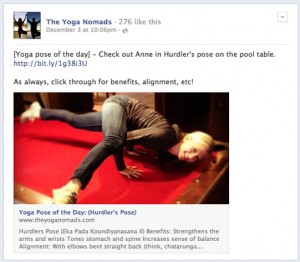 1. Be interesting!
1. Be interesting!
The most obvious tip is also the hardest one. I struggle with this a lot. It isn’t easy to consistently post things to your Facebook page that people find interesting. In tip #2 below, I talk about how important consistency is, but there is one thing that will trump that rule: It is better to not post at all than to post something uninteresting.
More Engagement = More Reach
If your post is interesting, your fans will tell Facebook by engaging that post (clicking LIKE, by commenting, or by sharing). Every time a fan engages with one of your posts, they are also telling Facebook they want to see more of your posts. Those types of fans are more like your ‘superfans’, and those superfans are gold on Facebook. If your fans aren’t engaging you, it means something is wrong.
The first step in being more interesting on Facebook is really taking a look at what you’re posting: Are you posting too many photos? Are you remembering that not every photo should be of you? Are you bragging? Are you just posting URL’s to articles without telling people what the article is about? It goes on and on, and the only way to know where you have been unintersting is to look at previous posts that flopped and learn from them. Don’t make the same mistake twice. Read every post once more before posting, and ask yourself: If I saw this in my feed, would I think it is interesting? If the answer is NO, then don’t post it.
It is also important to not get caught up in how many likes you have. Although likes are important, what is more important is that those likes are engaging you and that you are converting them into ‘superfans’. I’ll give you a great example of two nearly identically-sized Facebook pages, but where one is crushing the other in engagement. Let’s look at Hipmunk.com’s Facebook page vs. Skyscanner.com’s Facebook page:
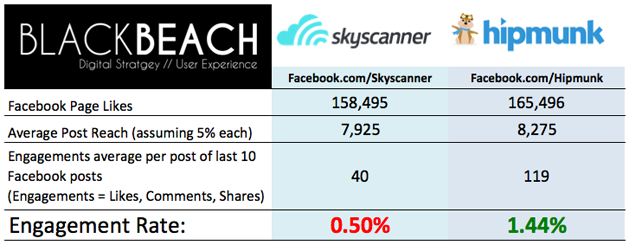
Source: BlackBeachDigital.com | December 2013
These two companies are in the same industry and even the same number of likes, BUT Hipmunk is able to engage nearly three times as many fans on average than Skyscanner does. Since Engagement=Reach, this also means three times more people are seeing Hipmunk’s posts compared to Skyscanner’s posts. THIS is why engagement is important. (In all fairness, Skyscanner looks to have had an abnormal last few weeks. Their engagement per post average is probably closer to 75)
The best way to learn social media is to observe those doing it well. Follow both Hipmunk and Skyscanner and watch what they do differently. The differences are actually pretty subtle, but the results are black and white. Hipmunk is constantly being more interesting and engaging their users better than Skyscanner. Hipmunk does everything I mention below and more, and they are killing it.
2. Post less often and BE CONSISTENT.
When you post less often, by default, Facebook will think each post is important and show them in more of your fans’ feeds right from the start. This is the easiest way to start increasing your post reach. If you post too often, you are just diluting the importance of each post and you are also telling Facebook to only show each story for less time, since they will use your average posts per day to know when to stop showing each post in peoples’ feeds.
That is also why consistency comes into play. If Facebook knows you post about 12 times a day, they will stop displaying a post in fans’ feeds after two hours because they are expecting you to post another story shortly. Some people worry too much about how often they post, when they should really be more worried about consistency. If you don’t have enough content to post once a day, THAT’S OK, but be aware of how much content you do have, and spread it out consistently. Facebook uses algorithms, and algorithms love patterns and consistency.
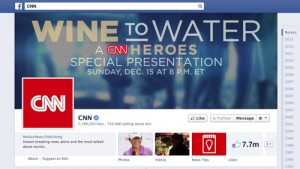 Think of it this way, the more content you have available and the more fans you have, the more you should post. CNN, for example, has thousands of articles of content available per day, and 7,000,000+ fans. And their average # of posts on Facebook is 24 per day, or once every hour. I bet the journalists and editors inside the CNN newsroom hate this. They probably would post something every five minutes if they could. But they don’t. Why? Because the marketing people hired someone smart to make sure CNN’s Facebook page reaches as many people as possible. In their A/B testing, they determined that they were getting the most engagement(likes/comments/shares) from their posts if they posted once per hour, consistently of course. This is free information for the little people like us, and now we can take our pages and scale it against what CNN has already determined. If they are posting once per hour with 1,000 of available stories and 7,000,000 fans, how often should we post with 1-2 stories available and 1,000 fans? The answer is LESS OFTEN, a lot less often.
Think of it this way, the more content you have available and the more fans you have, the more you should post. CNN, for example, has thousands of articles of content available per day, and 7,000,000+ fans. And their average # of posts on Facebook is 24 per day, or once every hour. I bet the journalists and editors inside the CNN newsroom hate this. They probably would post something every five minutes if they could. But they don’t. Why? Because the marketing people hired someone smart to make sure CNN’s Facebook page reaches as many people as possible. In their A/B testing, they determined that they were getting the most engagement(likes/comments/shares) from their posts if they posted once per hour, consistently of course. This is free information for the little people like us, and now we can take our pages and scale it against what CNN has already determined. If they are posting once per hour with 1,000 of available stories and 7,000,000 fans, how often should we post with 1-2 stories available and 1,000 fans? The answer is LESS OFTEN, a lot less often.
Ideally, a travel blogger should post 1-2 times per day. We never post more than three times a day on our page. If you have 25,000 fans and publish three things a day, then you should probably post 3-4 times per day.
3. Try not to post the same thing twice. OR ten times.
We all want more people to see how great one of our photos is, or how interesting an article is. But posting it three or four times is not the way to do it. Each time you post it again, Facebook assumes it is less important and then shows it to fewer fans. Post everything once. If your fans don’t like it or comment on it, it’s not because no one saw it. It’s because it wasn’t interesting enough. It probably sucked. It happens. Don’t keep posting it trying to get more legs out of it, it only hurts the reach of that post and future posts.
The same goes for themed posts or series of posts. Let’s say you decide to do a series of posts called “Weird Wednesdays” where each Wednesday you post a picture of something weird and ask you users to comment on it. Then, a couple of weeks into the series, you notice that the reach/engagement of each of the “Weird Wednesday” posts is bad. A bigger warning sign is if the reach is not only bad, but getting worse each week. In either case, the series should be stopped immediately. I see so many pages doing series or themes that aren’t working, yet they keep doing them thinking that the snowball is still small. What’s really happening is much worse. There is no snowball. Series of posts are a great way to come up with good, consistent content, but be sure you are listening to your fans and watching how they respond.
There are other exceptions too. Things like contests or post updates are OK, just make sure to change the post up each time so that it isn’t identical. If you’re posting about a contest 10 times in 30 days, at least use a new photo for the contest each time and be consistent with when you post each one. Here is Hipmunk doing it right (click the photo to enlarge). Notice the photo they use changes, as does the way they word the contest. The likes are way down in post number two (probably because some people are seeing it a second time), but the shares are higher in the second post.
4. It isn’t good when a user clicks “I don’t want to see this”.
Having multiple people click “I don’t want to see this” on one of your stories is the worst possible scenario for you when you post something to Facebook. It’s worse than a typo! GASP! Not only will that specific user immediately start seeing less of your posts, but it’s a vote telling Facebook that the post isn’t interesting. Always think about your fans as a whole when deciding what is relevant. If you know 95% of your users don’t live in your hometown, don’t flood your wall with posts about your hometown news. A harmless click of the “I don’t want to see this” from a random fan in France is just as bad as a your mom clicking it.
This is where Facebook has basically installed a voting system to ensure they, as well as you as the Page admin, know when your content is bad. When you see posts that don’t reach that many people, you have to remember that it is because the post wasn’t good. Don’t blame Facebook and definitely don’t blame your fans for the bad reach that the crappy sunset photo of your gross feet got. Remember, it isn’t the golf club that hit the bad shot, it’s the golfer.
Don’t just take my word for it. Here is an actual quote from Facebook about this:
It’s important to note that we constantly monitor signals from people in news feed, not only when they engage with a story or ad, but also when they hide a person’s story or a Page’s ad that they might not want to see or report a story as spam. Taking these signals into account, from time to time we make adjustments to the ranking system of news feed to ensure that news feed stories continue to be as engaging as possible. We have done this in the past and will continue to make adjustments so that people see the most relevant stories to them, every time they log in.
5. Be aware of what time it is… Everywhere
The majority of your readers have busy lives, full of careers, babies, oil changes, and happy hours. One of the best features of Facebook Pages is their Insights data. You can find out when your fans are online, specifically when they are on Facebook. You can increase the engagement and viewership of each status update by ensuring you are posting during peak times. Here is a screenshot of our data, showing that 8pm is the ideal time for us to post:
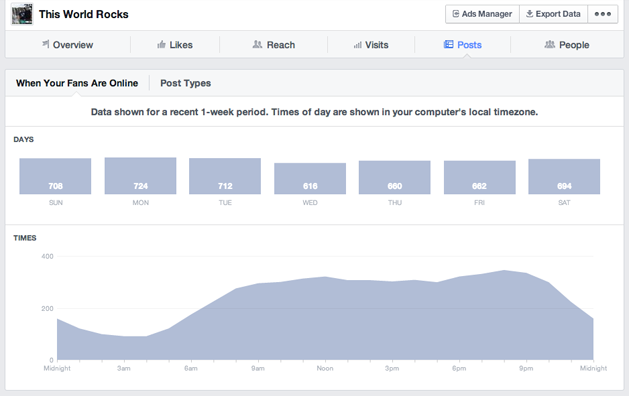
You can find that same graph for your Facebook Page, by clicking on Facebook Insights, then clicking Posts, When Your Fans Are Online. If you are a big deal and have fans all over the world, then just make sure to tailor your posts based on what region is currently awake and which is sleeping. Your Insights page will only show you the average of all your users, and can’t break the time data down by location.
Note: You can also get this same data on your Twitter followers using software called Tweriod. You never know which posts will go viral, but if you post something from Thailand when it’s 4pm there, what use is it if it’s 4am for your readers and they’re all asleep?
6. Know what types of Facebook posts your fans like
Facebook Insights also allows you to see how your fans reacted to each one of your status updates, photo updates, videos updates, etc. You can even sort your past posts to see which ones performed the best and which ones flopped. Study this data and find out what your fans like hearing about and sharing as well as what doesn’t appeal to them. This is one of the reasons we started doing more videos, as we found on here that our fans shared our videos more than our pictures.
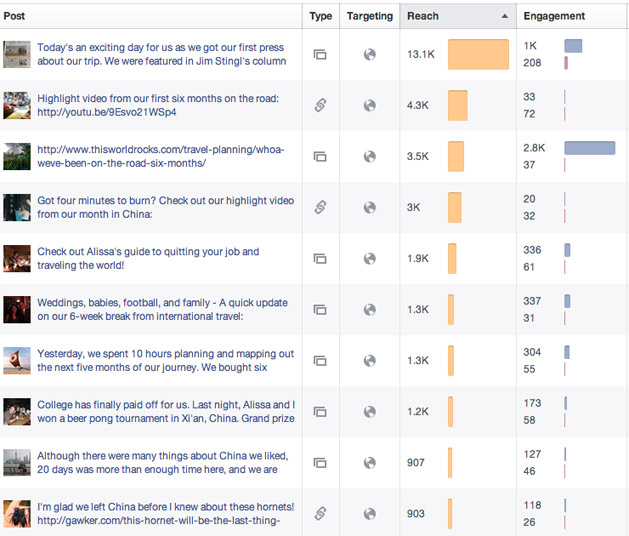
7. Don’t post selfies.
You know who you are. Selfies are RARELY interesting to anyone but you and your pet. If you must do them, post them on Twitter and Instagram instead.


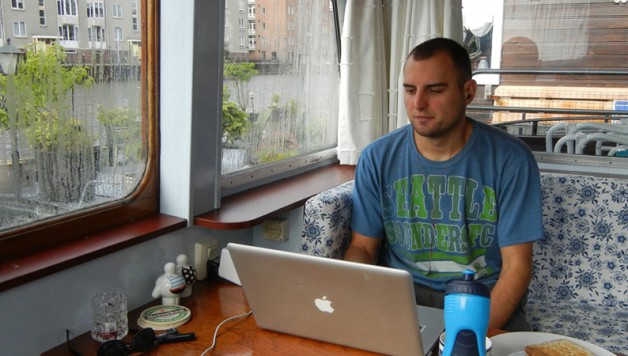
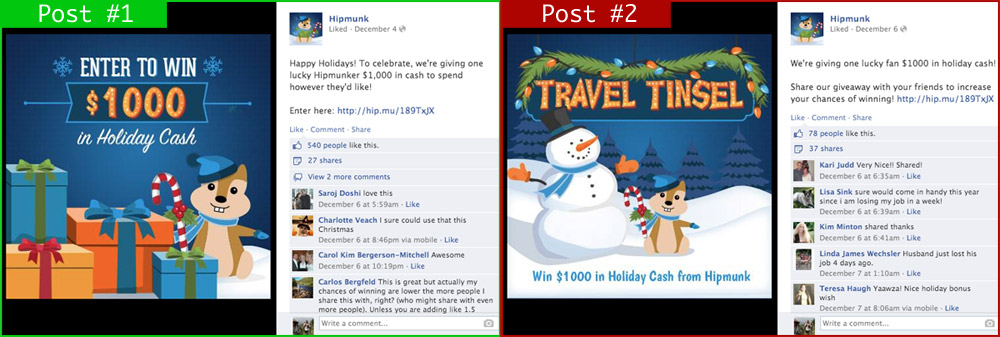

















Pingback: This World Rocks Six Social Media Tips for Aspiring Travel Bloggers | This World Rocks
Pingback: This World Rocks Why we no longer buy or use Lonely Planet books - This World Rocks